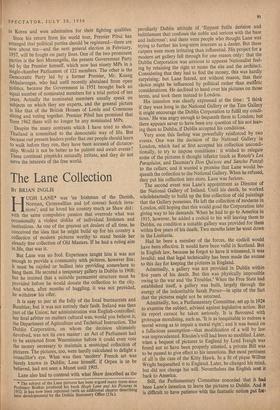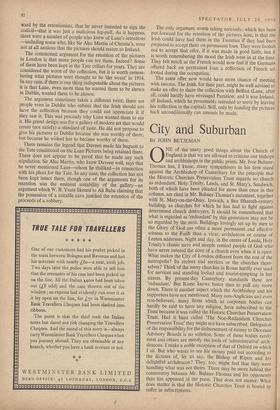The Lane Collection
By BRIAN INGLIS HUGH LANE* was 'an Irishman of the Danish, Norman, Cromwellian and (of course) Scotch inva- sions': and he loved his country much as Shaw did : With the same compulsive passion that overrode what was occasionally a violent dislike of individual Irishmen and Institutions. As one of the greatest art dealers of all time, he conceived the idea that he might build up for his country a collection of modern pictures worthy to stand beside her already fine collection of Old Masters. If he had a ruling aim in life, that was it.
But Lane was no fool. Experience taught him it was not enough to provide a community with pictures, however fine; it must be cajoled or bullied into providing somewhere to hang them. He secured a temporary gallery in Dublin in 1908; but he insisted that a suitable permanent structure must be Provided before he would donate the collection to the city. And when, after months of haggling, it was not provided, he withdrew his offer.
It is easy to jeer at the folly of the local bureaucrats and Bumbles; but it was not entirely their fault. Ireland was then Part of the Union; her administration was English-controlled; her final arbiter on matters cultural was, would you believe it, the Department of Agriculture and Technical Instruction. The Dublin Corporation, on whom the decision ultimately devolved, was not its own master: an Act of Parliament had to be extracted from Westminster before it could even vote the money necessary to maintain a municipal collection of Pictures. The pictures, too, were hardly calculated to delight a councillor's eye. What was then 'modern' French art was barely known in Dublin; Lane himself, if Orpen is to be believed, had not seen a Manet until 1905.
Lane also had to contend with what Shaw described as the peculiarly Dublin attitude of 'flippant futile derision and belittlement that confuses the noble and serious with the base, and ludicrous'; and there were people who thought Lane was trying to further his long-term interests as a dealer. But these carpers were more irritating than influential. His project for a modern art gallery fell through for one reason only: that the Dublin Corporation was anxious to appease Nationalist feel- ing by retaining the right to name the site and the architect. Considering that they had to find the money, this was hardly surprising; but Lane feared, not without reason, that their choice might be influenced by political rather than wsteetic considerations. He declined to hand over his pictures on those terms, and took them instead to London.
His intention was clearly expressed at the time: 'I think if they were hung in the National Gallery or the Tate Gallery it might encourage the Dublin Corporation to fulfil my condi- tions.' He was angry enough to bequeath them to London; but there appears never to have been any question of his not leav- ing them to Dublin, if Dublin accepted his conditions.
Very soon this feeling was powerfully reinforced by two events. One was the decision of the National Gallery in London, which had at first accepted his collection uncondi- tionally, to try to impose conditions : it wished to relegate some of the pictures it thought inferior (such as Renoir's Les Parapluies, and Daumier's Don Quixote and Sancho Panza) to the cellars; and it wanted a promise that Lane would be- queath the collection to the National Gallery. When he refused, they put his collection into store. Lane was furious.
The second event was Lane's appointment as Director of the National Gallery of Ireland. Until his death, he worked wholeheartedly to build up the fine collection of old paintings that the Gallery possesses. He left the collection of moderns in London, still hoping that this would goad the Corporation into giving way to his demands. When he had to go to America in 1915, however, he added a codicil to his will leaving them to Dublin, on condition a suitable gallery was provided for them within five years of his death. Two months later he went down in the Lusitania.
Had he been a member of the forces, the codicil would have been effective. It would have been valid in Scotland. But in English law, because he forgot to have it witnessed, it was invalid; and that legal technicality has been made the excuse to this day for keeping the pictures in England.
Admittedly, a gallery was not provided in Dublin within five years of his death. But this was physically impossible owing to the war and 'the Troubles.' When the Free State had established itself, a gallery was built, largely through the energy of the indomitable Sarah Purser—in spite of the fact that the pictures might not be returned.
Admittedly, too, a Parliamentary Committee, set up in 1924 to examine the subject, advised against legislative action. But its report cannot be taken seriously. It is flavoured with grotesque moralising, such as, 'It is as inequitable to redress a moral wrong as to impair a moral right'; and it was based on a fallacious assumption—that modification of a will by law was unprecedented. Rhodes's will had been so modified. Later, when a bequest of pictures to England by Lord Iveagh was found not to have been properly attested, a private Bill was to be passed to give effect to his intentions. But most pertinent of all is the case of the Kitty Hawk. In a fit of pique Wilbur Wright bequeathed it to England. Later, he changed his mind, but did not change his will. Nevertheless the English sent it back to America. ward by the retentionists, that he never intended to sign the codicil—that it was just a malicious leg-pull. As it happens, there were a number of people who knew of Lane's intentions —including some who, like Sir Alec Martin of Christie's, were not at all anxious that the pictures should return to Ireland.
The commonest argument for the retention of the pictures in London is that more people can see them. Indeed? Some of them have been kept in the Tate cellars for years. They are considered the worst of the collection, but it is worth remem- bering what pictures were thought to be `the worst' in 1914. In any case, if there is one thing indisputable about the pictures it is that Lane, even more than he wanted them to be shown in Dublin, wanted them to be shown.
The argument sometimes takes a different twist; there are people even in Dublin who submit that the Irish should not have the collection because they could not appreciate it if they saw it. This was precisely why Lane wanted them to see it. His grand design was for a gallery of modern art that would create (not satisfy) a standard of taste. He did not propose to give his pictures to Dublin because she was worthy of them; but because he wished her to beco,me worthy of them.
There remains the legend that Duveen made his bequest to the Tate conditional on the Lane Pictures being retained there. There does not appear to be proof that he made any such stipulation. Sir Alec Martin, who knew Duveen well, says that he never mentioned Lane—whom he disliked—in connection with his plans for the Tate. In any case, the collection has not been kept intact there, though one of the arguments for its retention was the eminent suitability of the gallery—an argument which W. B. Yeats likened to Ali Baba claiming that the possession of a suitable cave justified the retention of the proceeds of a robbery. The only argument worth taking seriously, which has been put forward for the retention of the pictures here, is that the Irish could have had them in the Twenties if they had been prepared to accept them on permanent loan. They were foolish not to accept that offer, if it was made in good faith; but it is worth remembering the mood the Irish were in at the time. They felt much as the French would now feel if the Germans offered back on permanent loan a collection of French art looted during the occupation.
The same offer now would have more chance of meeting with success. The Irish, for their part, might be well advised to make an offer to share the collection with Belfast (Lane, after all, could hardly have envisaged Partition; and it was Ireland. all Ireland, which he presumably intended to serve by leaving his collection to the capital). Still, only by handing the pictures back unconditionally can amends be made.



















































 Previous page
Previous page